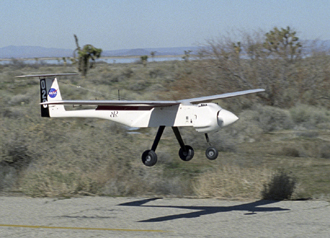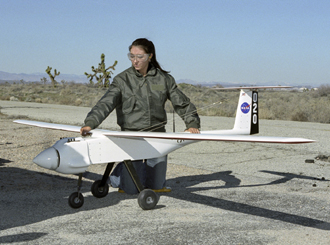 The old saying, “birds of a feather, flock together,” can now be applied to a couple of small uninhabited aerial vehicles (UAVs) flown in a NASA research experiment using principles derived from studies of fish and bird motions to simultaneously guide them around obstacles.
The old saying, “birds of a feather, flock together,” can now be applied to a couple of small uninhabited aerial vehicles (UAVs) flown in a NASA research experiment using principles derived from studies of fish and bird motions to simultaneously guide them around obstacles.
Image Right: One of two small APV-3 aircraft flown in the joint Ames-Dryden Networked UAV Teaming Experiment flares for landing on a roadway on a remote area of Edwards AFB.
Engineers and technicians from NASA’s Ames Research Center, Moffett Field, Calif., and Dryden Flight Research Center, Edwards, Calif., recently conducted flight tests over a ‘virtual’ forest fire to evaluate new flight-control software that will allow UAVs the ability to autonomously react to obstacles as they fly pre-programmed missions. The tests were conducted over a remote area of Edwards Air Force Base, Calif., to investigate cooperative flight strategies for airborne monitoring and surveillance of natural disasters and for atmospheric sampling.
“We developed and flight tested several novel approaches for providing assistance to wildfire suppression crews using a team of two small UAVs,” said Ames’ John Melton, principal investigator for the Networked UAV Teaming Experiment. “The aircraft were flown using a combination of rules from nature and robotics to cooperatively transit and search a virtual forest fire.”
 Image Left: NASA Dryden Operations co-op student Shannon Kolensky holds one of the APV-3 UAVs flown in the Networked UAV Teaming Experiment steady during an engine runup.
Image Left: NASA Dryden Operations co-op student Shannon Kolensky holds one of the APV-3 UAVs flown in the Networked UAV Teaming Experiment steady during an engine runup.
The NASA researchers borrowed a mathematical tool devised by Hollywood movie makers to map and mimic the choreography used by swarms of birds and fish as they wheel and turn without striking one another. These in turn guided the inexpensive robotic UAVs around obstacles such as simulated smoke plumes. Called the boid algorithm, this tool separates the activities of individual birds or fish into three categories: heading matching, where the animals all try to keep the same direction; flocking, where the animals move to come into proximity to one another; and collision avoidance, in which the birds or fish maneuver to keep from running into each other.
Jason Clark, research algorithm developer at NASA Dryden, said the boid algorithm has been adapted to direct remotely operated UAVs to fly within predetermined proximity to each other, while avoiding collisions and maneuvering around phantom objects digitally placed in their flight paths. Though still in its infancy, this emerging software technology promises to one day enable swarms of UAVs to conduct aerial searches and participate cooperatively in activities such as firefighting.
For the tests, NASA used the Piccolo autopilot system and global positioning system (GPS) transmitters to enable a pair of RnR Products APV-3 UAVs to maneuver responsively in relation to each other. With the two 12-foot wingspan UAVs, the NASA researchers proved the concepts inherent in the boid algorithm. Neither aircraft communicated with the other directly, but sent and received signals with a central computer station on the ground that directed both airplanes to maneuver as needed.
In one test, the software automatically developed individual flight plans and transmitted them to each aircraft. After passing their first few waypoints, one of the UAVs was commanded to begin orbiting over the virtual fire. The remaining search points were then transmitted to the second aircraft, which incorporated these points into its flight plan and completed the mission.
“This technology may one day enable swarms of aircraft to move safely from one area to another as a flock or group,” said Melton. “A number of UAVs could be flown ‘stacked’ in a vertical column with instruments to collect air samples on future science missions or help ground personnel monitor forest fires and other natural disasters,” he added.
NASA’s Aeronautics Research Mission Directorate is supporting a variety of technology development projects for remotely or autonomously controlled high-altitude, long-endurance UAV aircraft. Such UAVs have the potential to serve as platforms for a wide variety of earth science, surveillance, communications relay and disaster-mitigation missions, especially in circumstances where flying a manned aircraft is dangerous. The Networked UAV Teaming Experiment was sponsored by the Directorate’s Aeronautics Systems Analysis Project.
-NASA-
PHOTO EDITORS: High-resolution photos to support this release are available electronically on the NASA Dryden photo gallery at: http://www1.dfrc.nasa.gov/Gallery/Photo/APV-3_NUAVT/index.html.
TELEVISION EDITORS: Interview segments and B-roll footage to support this release will be aired during the Video File feeds on NASA TV on March 18 and 21. NASA TV is available on the Web and via satellite in the continental U.S. on AMC-6 at 72 degrees west longitude, transponder 9, 3880 MHz, vertical polarization, audio at 6.8 MHz. In Alaska and Hawaii, NASA TV is available on AMC-7 at 137 degrees west longitude, transponder 18, at 4060 MHz, vertical polarization, audio at 6.8 MHz. For NASA TV information and schedules on the Internet, visit: https://www.nasa.gov/ntv.
– end –
text-only version of this release
To receive status reports and news releases issued from the Dryden Newsroom electronically, send a blank e-mail message to dfrc-subscribe@newsletters.nasa.gov. To unsubscribe, send a blank e-mail message to dfrc-unsubscribe@newsletters.nasa.gov. The system will confirm your request via e-mail.
Dryden Flight Research Center
P.O. Box 273
Edwards, California 93523
Phone 661/276-3449
FAX 661/276-3566
Beth Hagenauer
NASA Dryden Flight Research Center
Phone: 661/276-7960
beth.hagenauer@dfrc.nasa.gov
Jonas Dino
NASA Ames Research Center
Phone: 650/604-5612
jonas.dino@nasa.gov






















